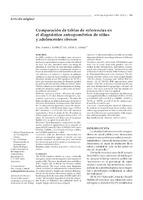Por favor, use este identificador para citar o enlazar este ítem:
http://sgc.anlis.gob.ar/handle/123456789/211| Título : | Comparación de tablas de referencias en el diagnóstico antropométrico de niños y adolescentes obesos | Otros títulos : | Comparation of reference tables In the anthropometric diagnosis of obese children and adolescents | Autor : | Gotthelf, Susana J. Jubany, Lilian L. |
Palabras clave : | Obesidad;Antropometría;Niño;Adolescente | Fecha de publicación : | 2005 | Descripción : | La OMS considera a la obesidad como un nuevo síndrome de emergencia mundial cuyo aumento se traduce en repercusiones negativas sobre la calidad de vida. Por ello, identificar niños con riesgo de obesidad se convierte en una prioridad sanitaria. Los criterios diagnósticos ampliamente usados se basan en determinaciones antropométricas del peso con relación a la estatura y espesor de pliegues cutáneos. La mayoría de los estudios caracterizan la obesidad infantil con el IMC (gráficas de NCHS y Cole). La Sociedad Argentina de Pediatría publicó las gráficas de relación peso/talla para niños/niñas. Objetivo: Observar si existen diferencias en el diagnóstico de obesidad, según la utilización de distintas tablas de referencia. Población, material y métodos. 303 niños de ambos sexos entre 3 y 17 años. Estudio retrospectivo, descriptivo, transversal y comparativo. Revisión de historias clínicas de niños tratados por obesidad en el Centro Nacional de Investigaciones Nutricionales. Se utilizaron los siguientes valores de referen-cia: peso/talla >120 obesidad (Lejarraga y Orfila); IMC obesidad > al Pc.95 (NCHS); IMC obesidad equivalente a 30 en el adulto (Cole). El análisis se realizó según sexo y en 2 grupos etarios (<10 y >10 años). Se procesaron los datos por el programa EpiInfo 6.0 y se aplicó la prueba de X 2 . Resultados. En el diagnóstico comparativo, las diferencias resultaron significativas en la muestra en general (SAP contra NCHS p= 0,0000001; SAP contra COLE p= 0,00000...; COLE contra NCHS p= 0,009) y en el análisis según sexo y edad. Conclusión. Ante las diferencias observadas, los autores recomiendan repetir el estudio con una muestra ampliada de población para seleccionar las referencias que más se ajusten a nuestras características antropomórficas. The WHO considers obesity as a new worldwide emergency, its increase has negative repercussions on quality of life. Therefore, the identification of children with a higher risk of obesity has become a public health priority. The most widely used diagnostic criteria are based on anthropometric determinations of weight related to height and skinfold thickness. Nearly all the studies characterize obesity in childhood using the body mass index (NCHS and Cole’s charts). The Sociedad Argentina de Pediatría (Argentine Society of Pediatrics) has published charts of weight/height ratios for boys and girls. Objective. To determine if there are differences in the diagnosis of obesity according to the use of different reference charts. Population, materials and methods. 303 children aged from 3 to 17 years, from both genders, were included in this retrospective, descriptive, crossectional, and comparative study. The medical records of children treated for obesity at the National Center for Nutritional Research were reviewed. The following reference values were used: weight/height >120 for obesity (Lejarraga and Orfila); BMI for obesity >Pc 95 (NCHS); BMI equivalent to adult obesity= 30 (Cole). Analyses were performed by sex and were divided in two age-groups (<10 and >10 years). Data were processed with the EpiInfo 6.0 program and the X 2 test was applied. Results. In the comparative diagnosis, the differences were significant in the overall sample (SAP vs. NCHS, p= 0.0000001; SAP vs. COLE, p= 0.00000…; COLE vs. NCHS, p= 0.009), as well as in the analyses performed by sex and by age. Conclusion. Considering the observed differences, the authors recommend to perform another study with a larger population in order to select the reference chart that is more representative of the Argentine anthropomorphic characteristics. Fil: Gotthelf, Susana Judith. ANLIS Dr.C.G.Malbrán. Centro Nacional de Investigaciones Nutricionales Dr. Arturo Oñativia. Departamento de Investigación Clínica; Argentina. Fil: Jubany, Lilian L. ANLIS Dr.C.G.Malbrán. Centro Nacional de Investigaciones Nutricionales Dr. Arturo Oñativia. Departamento de Investigación Epidemiológica; Argentina. |
URI : | http://www.sap.org.ar/staticfiles/archivos/2005/arch05_2/A2.129-134.pdf http://sgc.anlis.gob.ar/handle/123456789/211 |
ISSN : | 1668-3501 | Derechos: | info:eu-repo/semantics/openAccess |
| Aparece en las colecciones: | snrd Publicaciones CeNIN |
Ficheros en este ítem:
| Fichero | Descripción | Tamaño | Formato | |
|---|---|---|---|---|
| ArchivosArgentinosdePediatría,2005,103(2),129–134.pdf | 81.52 kB | Adobe PDF |  Visualizar/Abrir |
Visualizaciones de página(s)
1.935
comprobado en 28-nov-2025
Descarga(s)
477
comprobado en 28-nov-2025
Google ScholarTM
Consultar
Los ítems de DSpace están protegidos por copyright, con todos los derechos reservados, a menos que se indique lo contrario.

